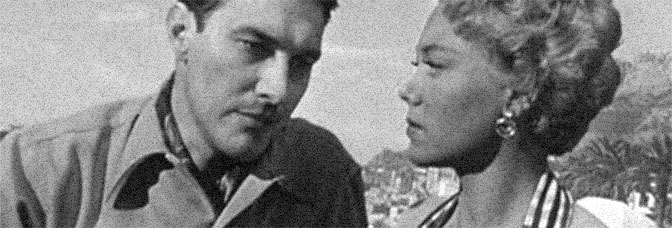With the exception of some overly confident rear screen projection and a problematic middle story, Encore is an almost entirely successful anthology of three W. Somerset Maugham stories. Each story has a different director and screenwriter; otherwise the crew is the same.
Maugham introduces each story, usually saying something to mildly detract from it–he emphasizes the stories being fictionalizations of real life, which seems a tad pointless, but it’s better than when he assails one of his characters. More on that one in a bit.
The first story is an extremely dry comedy, with loafing Nigel Patrick trying to get money out of his successful older brother, played by Roland Culver. Pat Jackson directs it, T.E.B. Clarke does the script for it. Both Patrick and Culver are fantastic–Patrick’s solution to Culver not lending him money is to take menial jobs in Culver’s social circle to humiliate him. So for a while the segment is just Patrick being a perfect bastard and Culver getting more and more frustrated. The jobs are always funny–and always involve Culver’s bewildered client, Charles Victor–before it takes a very fun turn at the end.
Clarke’s script is fast and funny, Jackson’s direction is the same. Jackson lets Patrick walk off with scenes (usually over Culver–but not always) to great effect.
From that very high start, Encore immediately gets in to trouble with the second segment. It starts before the segment itself, with Maugham complaining about a woman he once didn’t like. It’s appropriate, dire forecasting.
Directed by Anthony Pelissier and written by Arthur Macrae, the second segment is about annoying cruise ship passenger Kay Walsh. No one can stand her. She’s talkative and friendly, which is obnoxious to captain Noel Purcell and ship’s doctor Ronald Squire. Lots of the complaints have to do with Walsh being a woman, which seems like lazy writing on someone’s part (Macrae’s or Maugham’s), and it reduces every character in the segment to a caricature. At the end, it turns out the caricatures were intentional so there could be a last minute reveal.
Despite the characters being astoundingly thin, the performances are all generally fine. Once she gets to do, Walsh is quite good (good enough someone should’ve rethought the adaptation of the story, as it’s no good for film). Pelissier’s direction, albeit peppered with stock footage of the ocean, the Bahamas, and so on, is quite good. He’s directing for the actors, shame the script isn’t there for them.
The final segment starts with yet another troubling introduction from Maugham. It’s going to be about dangerous stunt performers, he says, who he wishes would just do something safer.
Glynis Johns (top-billed for the whole picture) is a high diver. She dives eighty feet into five feet of water, which is covered in flames. She does it twice a night for rich diners at a Riviera resort. Husband Terence Morgan is her announcer and manager. Johns is getting sick of the life, while Morgan is negotiating longer and longer, and more and more lucrative, contracts for her. When they meet retired daredevil Mary Merrall (and her husband, Martin Miller), Johns’s crises become more immediate.
Harold French directs this segment, from a script by Eric Ambler. It’s the biggest segment–though there’s still some questionable rear screen projection on the Riveria, there’s a physical eighty-foot diving platform and a lot of sets. There’s the restaurant, there’s a casino, it’s a lot more open than either of the preceding segments. It’s not about the sets or the stunts, however, it’s all about Johns and her growing fear. About Morgan and his working class dreams. Of the three, it embraces its sentimentality the most and is the most ambitious. French and Ambler don’t have a last minute reveal or some really funny situational comedy to fall back on. They just have the actors. And the actors succeed.
Excellent performances–from Patrick, Culver, Walsh, Johns, Morgan, and Merrall–excellent direction, solid production values (excepting the problematic rear screen, of course) result in an entirely satisfactory, rather successful film.
 ★★★
★★★
CREDITS
Directed by Pat Jackson, Anthony Pelissier, and Harold French; screenplay by T.E.B. Clarke, Arthur Macrae, and Eric Ambler, based on stories by W. Somerset Maugham; director of photography, Desmond Dickinson; edited by Alfred Roome; music by Richard Addinsell; produced by Antony Darnborough; released by General Film Distributors.
Starring Nigel Patrick (Tom Ramsay), Roland Culver (George Ramsay), Charles Victor (Mr. Bateman), Peter Graves (Philip Cronshaw), Kay Walsh (Miss Molly Reid), Noel Purcell (Captain), Ronald Squire (Doctor), Jacques François (Pierre), John Horsley (Joe, Mate), Glynis Johns (Stella Cotman), Terence Morgan (Syd Cotman), Mary Merrall (Flora Penezzi), and Martin Miller (Carlo Penezzi).

Leave a Reply